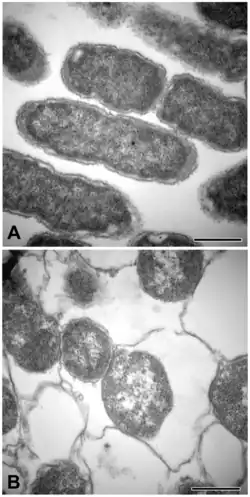Viable but nonculturable

Viable but nonculturable (VBNC) bacteria refers as to bacteria that are in a state of very low metabolic activity and do not divide, but are alive and have the ability to become culturable once resuscitated.[1]
Bacteria in a VBNC state cannot grow on standard growth media, though flow cytometry can measure the viability of the bacteria.[1] Bacteria can enter the VBNC state as a response to stress, due to adverse nutrient, temperature, osmotic, oxygen, and light conditions.[1] The cells that are in the VBNC state are morphologically smaller, and demonstrate reduced nutrient transport, rate of respiration, and synthesis of macromolecules.[1] Sometimes, VBNC bacteria can remain in that state for over a year.[1] It has been shown that numerous pathogens and non-pathogens can enter the VBNC state, which therefore has significant implications in pathogenesis, bioremediation, and other branches of microbiology.[1]
The existence of the VBNC state is controversial. The validity and interpretation of the assays to determine the VBNC state have been questioned.[2]
VBNC pathogens
Species known to enter a VBNC state:[3]
- Aeromonas hydrophila
- Aeromonas salmonicida
- Agrobacterium tumefaciens
- Burkholderia cepacia
- Burkholderia pseudomallei
- Brettanomyces bruxellensis[4]
- Campylobacter coli
- Campylobacter jejuni
- Campylobacter lari
- Cytophaga allerginae
- Enterobacter aerogenes
- Enterobacter cloacae
- Enterococcus faecalis
- Enterococcus hirae
- Enterococcus faecium
- Erwinia amylovora
- Escherichia coli (including EHEC)
- Francisella tularensis
- Helicobacter pylori
- Klebsiella aerogenes
- Klebsiella pneumoniae
- Klebsiella planticola
- Legionella pneumophila
- Listeria monocytogenes
- Micrococcus luteus
- Mycobacterium tuberculosis
- Mycobacterium smegmatis
- Pasteurella piscicida
- Pseudomonas aeruginosa
- Pseudomonas syringae
- Pseudomonas putida KT2440[5]
- Ralstonia solanacearum
- Rhizobium leguminosarum
- Rhizobium meliloti
- Salmonella enterica
- Salmonella Typhi
- Salmonella Typhimurium
- Serratia marcescens
- Shigella dysenteriae
- Shigella flexneri
- Shigella sonnei
- Streptococcus faecalis
- Tersicoccus phoenicis [6]
- Vibrio alginolyticus
- Vibrio anguillarum
- Vibrio campbellii
- Vibrio cholerae
- Vibrio harveyi
- Vibrio mimicus
- Vibrio parahaemolyticus
- Vibrio shiloi
- Vibrio vulnificus (types 1 and 2)
- Xanthomonas campestris
- Xanthomonas axonopodis pv. citri
- Yersinia pestis[7]
References
- ^ a b c d e f Oliver JD (February 2005). "The viable but nonculturable state in bacteria". The Journal of Microbiology. 43 (special issue (No. S)): 93–100. PMID 15765062.
- ^ Stokell JR, Steck TR (2012). "Viable but Nonculturable Bacteria". eLS. doi:10.1002/9780470015902.a0000407.pub2. ISBN 978-0470016176.
- ^ Oliver JD (July 2010). "Recent findings on the viable but nonculturable state in pathogenic bacteria". FEMS Microbiol Rev. 34 (4): 415–25. doi:10.1111/j.1574-6976.2009.00200.x. PMID 20059548.
- ^ Capozzi V, Di Toro MR, Grieco F, Michelotti V, Salma M, Lamontanara A, et al. (2016). "Viable But Not Culturable (VBNC) state of Brettanomyces bruxellensis in wine: New insights on molecular basis of VBNC behaviour using a transcriptomic approach". Food Microbiology. 59: 196–204. doi:10.1016/j.fm.2016.06.007. PMID 27375260.
- ^ Pazos-Rojas LA (July 2019). "Desiccation-induced viable but nonculturable state in Pseudomonas putida KT2440, a survival strategy". PLOS ONE. 17 (7): e0219554. Bibcode:2019PLoSO..1419554P. doi:10.1371/journal.pone.0219554. PMC 6641147. PMID 31323038.
- ^ Tirumalai M, Ali S, Fox GE, Widger W (August 2025). "Tersicoccus phoenicis (Actinobacteria), a spacecraft clean room isolate, exhibits dormancy". Microbiology Spectrum. 0: e01692-25. doi:10.1128/spectrum.01692-25. PMID 40788184.
- ^ Pawlowski DR, Metzger DJ, Raslawsky A, Howlett A, Siebert G, Karalus RJ, et al. (2011). "Entry of Yersinia pestis into the viable but nonculturable state in a low-temperature tap water microcosm". PLOS ONE. 6 (3): e17585. Bibcode:2011PLoSO...617585P. doi:10.1371/journal.pone.0017585. PMC 3059211. PMID 21436885.